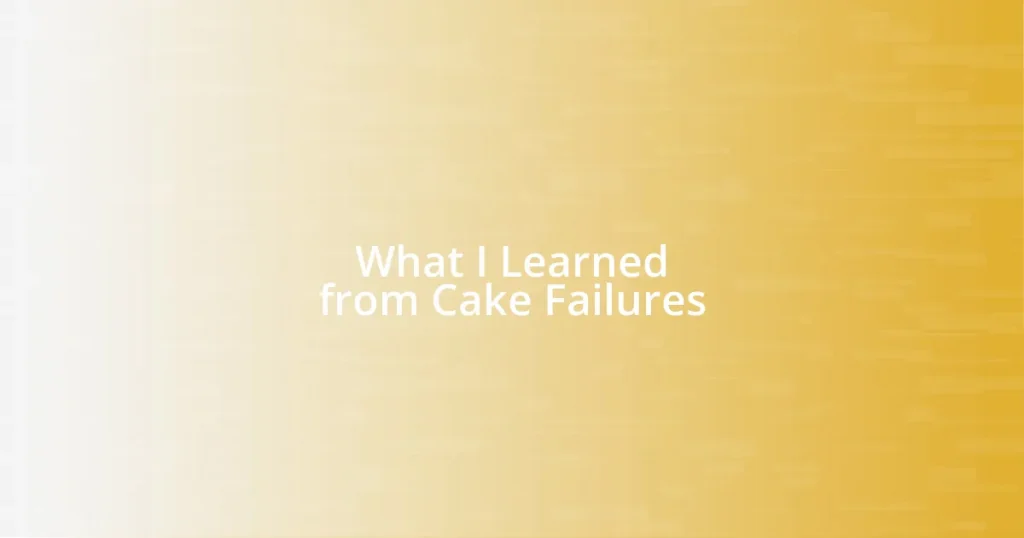Key takeaways:
- Cake failures present valuable learning opportunities, teaching important baking techniques and ingredient interactions.
- Common mistakes include neglecting recipe details, inaccurate measurements, and improper ingredient handling, which can significantly affect the outcome.
- Understanding the unique roles of ingredients like butter, sugar, and eggs is crucial for achieving the desired texture and flavor in cakes.
- Celebrating successful bakes not only boosts confidence but also enhances the joy of sharing creations with loved ones.

Introduction to Cake Failures
Cake failures are often seen as just setbacks in the pursuit of baking perfection, but I believe they offer invaluable lessons. I remember a time when I tried to recreate a family recipe, only to have the cake collapse in the middle. It was disappointing, of course, but I learned more about oven temperatures and the importance of leveling my ingredients than I ever would have from a perfect bake.
Have you ever faced a cake disaster? I can still feel the flop of that sponge cake I attempted for my best friend’s birthday—a mix of overbeating and underbaking left me with a dense puck instead of the fluffy treat I envisioned. It was a humbling moment that taught me the intricacies of mixing methods and how each small step contributes to the whole.
Embracing cake failures is crucial for growth in the kitchen. Each mishap is an opportunity to analyze what went wrong. This journey not only improves my baking skills but also adds layers of resilience and creativity, transforming moments of frustration into stepping stones toward success.

Common Cake Mistakes to Avoid
One pitfall I’ve often encountered in my baking adventures is neglecting to read the recipe thoroughly before diving in. I remember staring at my mixing bowl, excited to whip up a gorgeous three-layer cake until I realized I’d skipped the critical step of preheating the oven. The resultant flat, sad layers served as a stark reminder that every detail counts in baking.
To help you avoid common cake mistakes, consider these tips:
- Not measuring ingredients accurately: Eye-balling ingredients can lead to disastrous results. Always use a scale or measuring cups for precision.
- Skipping the oven preheat: I learned the hard way that starting with a cold oven can ruin the texture of your cake.
- Overmixing the batter: It might be tempting to beat the mixture until it’s smooth, but overmixing can result in a tough cake.
- Failing to level the ingredients: Ingredients like flour should be leveled off with a knife; otherwise, you may end up with too much and throw off the balance.
- Using old baking soda or powder: I once baked a cake with ancient leavening agents, and well, it didn’t rise at all. Always check the expiration dates!

Understanding Cake Ingredients Effects
Understanding how different cake ingredients interact can make all the difference between a moist and fluffy cake and a disappointing lump. For instance, I once experimented with replacing butter with oil in a recipe, thinking it would provide a moist texture. Instead, my cake turned out overly dense because the ratios of fat to liquid were off, teaching me that not all fats work the same way in baking.
Another essential aspect is sugar. During one of my baking sessions, I decided to add extra sugar to a chocolate cake recipe to enhance the sweetness. To my surprise, the result was an overly sweet and cloying cake that completely overshadowed the rich chocolate flavor. This experience highlighted how sugar not only sweetens but also affects the cake’s structure and moisture.
Finally, let’s talk about eggs. In a bid to create a lighter texture for a sponge cake, I used only egg whites instead of whole eggs, thinking this would result in a fluffier outcome. However, the cake was dry and lacked the richness whole eggs provide. From this, I learned that each component plays a unique role in the cake’s texture, flavor, and overall success.
| Ingredient | Effect on Cake |
|---|---|
| Butter | Provides richness and flavor; contributes to tender texture |
| Oil | Keeps cakes moist but may yield denser results if misused |
| Sugar | Adds sweetness; impacts texture and moisture |
| Eggs | Enhance structure; whole eggs create richness, whites add fluffiness |

Techniques for Perfect Cake Texture
In my quest for the perfect cake texture, I’ve discovered the incredible power of room-temperature ingredients. I often forget this step, thinking it’s no big deal. However, when I used cold eggs straight from the fridge, my batter took on a lumpy texture that left me feeling frustrated. Room-temperature eggs blend seamlessly into the batter, resulting in a smooth and uniform mixture that bakes evenly. Isn’t it fascinating how seemingly minor details can lead to significant changes in our baking?
Another technique that transformed my cake game is the creaming method. I remember the first time I meticulously creamed butter and sugar together—I could hardly believe the fluffy texture that emerged. This step incorporates air, which is crucial for creating that light, airy bite we all crave. It’s amazing to think that dedicating a few extra minutes to this seemingly simple process could result in a cake that feels like clouds on the palate.
And then there’s the choice of pan. I once was in a pinch and used a glass dish instead of my trusty metal pan, thinking it wouldn’t make a big difference. The result? A cake that baked unevenly and ended up with a burnt outside and gooey center—definitely not the masterpiece I envisioned! I realized that the right pan distributes heat more effectively, allowing for that golden crust and moist interior. What’s a cake without harmony in texture, anyway?

Troubleshooting Cake Baking Issues
When it comes to troubleshooting cake baking issues, I’ve found that the order of ingredient incorporation can be crucial. I once whipped my egg whites to soft peaks before adding them to the batter, thinking that would give my cake an airy texture. Instead, my cake didn’t rise as expected; the whites deflated in the mixing process. Lesson learned: gentle folding can maintain that precious air, leading to much better volume.
Another common issue is overmixing. I still remember the first time I made a marble cake, and I got so excited about the beautifully swirled batter that I whisked it too much. My cake ended up dense and sad, lacking the soft crumb I envisioned. It’s amazing how simply knowing to mix just until combined can make all the difference, resulting in a cake that dances on your taste buds instead of plods along like a heavy brick.
Temperature is another sneaky culprit behind cake failures. I once popped a cake in the oven without preheating, just assuming it would work out fine. Oh boy, was I wrong! My cake didn’t rise properly, giving me an unsightly flat top. Now, I treat preheating like a sacred ritual—after all, the right oven temperature helps cakes develop their structure and flavor, ensuring that each slice is a delightful experience. Have you ever had a baking mishap that taught you about the importance of temperature? I can certainly relate!

Learning from My Cake Fails
I’ve had my fair share of cake failures that taught me valuable lessons. One particularly memorable incident involved my attempt at a red velvet cake for a friend’s birthday. Instead of the vibrant red I hoped for, I ended up with a dull, chocolatey-looking mess because I skimped on the food coloring. It was a real reminder that each ingredient has its role in not just taste but presentation too. Did I let it ruin my day? Absolutely not! I learned that vibrant colors can make a cake feel festive, and I’ve never skimped on color since.
The first time I tried to make a sponge cake, I was so eager that my oven was still cooling down when I tossed it in. You can imagine the outcome—a flat, sad excuse for a cake. It’s those little moments of impatience that bite back the hardest! Now I double-check my oven temperature and let my ingredients settle into their perfect spots, because the right environment can transform a good cake into something extraordinary. Have you ever rushed a baking process? I know I have, and it’s taught me the importance of patience in the kitchen.
Another fascinating lesson involved using baking powder versus baking soda in a lemon cake recipe. I trusted my memory and grabbed baking powder, only to have my cake rise beautifully in the oven, then deflate dramatically upon cooling. I chuckled at my mistake because, really, it felt like I was re-learning chemistry all over again. From then on, I’ve made it a habit to verify my ingredients, ensuring the flavors and textures align with my vision. Isn’t it funny how baking can feel like an experiment where precision is key? I’ve come to appreciate the science behind this art form so much more.

Celebrating Success in Cake Baking
There’s something incredibly rewarding about pulling a beautifully baked cake from the oven. I remember the thrill when I first baked a chocolate cake that rose perfectly and had that glossy ganache on top. As I sliced through that soft, moist layer, my heart swelled with pride. It was a moment that reminded me why I fell in love with baking in the first place—the joy of creation and the satisfaction of seeing my efforts materialize into something wonderful. Have you ever experienced that rush of excitement when a cake turns out just right? It’s simply unforgettable.
One of the most gratifying celebrations in my baking journey came when I made a layered vanilla cake for my niece’s birthday. With each fluffy layer stacked carefully and adorned with sprinkles, I felt like a true artist. Watching her eyes light up when she saw it made the hours spent measuring and mixing feel utterly worthwhile. I’ve learned that these celebratory moments, no matter how small, serve as milestones in our baking adventures. They remind us to pause and appreciate the fruits of our labor, don’t you think?
The experience of sharing a successful bake is where the joy truly amplifies. I often host small gatherings just to present my newest cake creations, and I cherish the laughter and compliments that come my way. It’s a wonderful way to connect with family and friends over something I love. I can feel the love in each slice, and it’s moments like these that make me realize that baking is so much more than just a craft; it’s about bringing people together. What’s the best cake you’ve shared with your loved ones? Each successful bake feels like a reason to celebrate, and they certainly deserve their spotlight!















